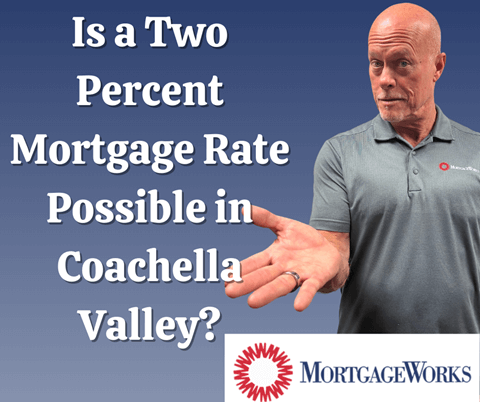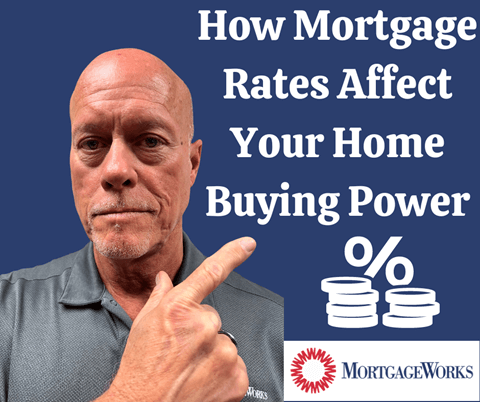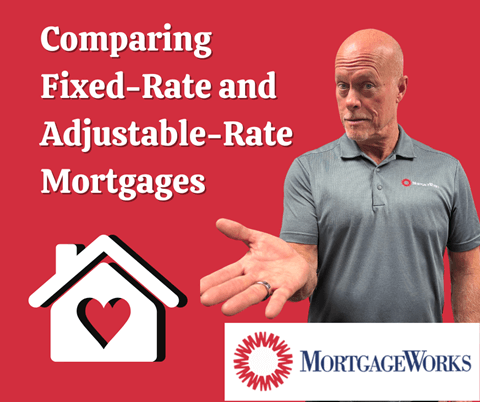
Let’s get real about the two percent mortgage rate. It sounds like a dream, right? But before you start packing your boxes for that new home in Coachella Valley, there’s more to it. The buzz around this elusive rate often misses key facts – like how rare they are and what influences rates to begin with.
This isn’t just about snagging an ultra-low rate; it’s also knowing when those numbers actually make sense for you. We’ll dig into the current climate of mortgage rates and trends that play a big role in what you’ll pay.
Understanding these details can be game-changing, especially if you’re looking at fixed-rate mortgages or thinking about adjustable-rate options. So stick around – because by the end of this read, navigating through credit scores, closing costs, and all things mortgage will feel less daunting.
MortgageWorks offers financing for new home purchases, refinance, home equity, investment property, construction, and a wide variety of loan program options to fit your every need. Servicing California and the entire Coachella Valley, including Palm Springs, Cathedral City, Rancho Mirage, Indian Wells, Palm Desert, Desert Hot Springs, La Quinta, Indio, and Coachella. Call Art today @ (760) 883-5700
Demystifying the 2% Mortgage Rate Myth
You’ve probably seen those eye-catching ads promising a two percent mortgage rate. But before you start dreaming of low monthly payments, let’s set the record straight: no lender is handing out new loans at that rate today. What we’re seeing is classic clickbait, folks—headlines crafted to reel you in.
Clickbait Headlines vs. Reality in Mortgage Advertising
Sensational headlines about a two percent mortgage rate can mislead eager homebuyers into thinking these deals are just waiting to be snapped up. Yet, when you peel back the layers and read all the details, it becomes clear that this number isn’t rooted in reality for current mortgages within our housing market or anywhere else for that matter.
The truth is often hidden behind technical jargon or buried deep in terms and conditions—which most people skip over anyway. That lack of follow-up on what truly influences mortgage rates leads many down a rabbit hole filled with misinformation.
Reading Beyond the Headline for Accurate Mortgage Information
To navigate through misleading headlines effectively, one must become savvy enough not only to spot them but also to understand what they aren’t telling us. The real estate game has its fair share of traps and pitfalls designed to catch your attention without giving anything substantial back; hence why thorough research and correction of misinformation are paramount.
MortgageWorks knows firsthand how confusing this world can be—we help customers by providing clarity amidst chaos because we believe helping people make informed decisions strengthens our entire community here in the Coachella Valley.
In sum, while juicy tidbits like ‘two percent mortgage rates’ might spark initial interest from first-time buyers or anyone looking to refinance their homes—it’s crucial not only to compare offers from multiple lenders but also to keep an eagle eye on factors such as Freddie Mac‘s average rate reports which paint a more accurate picture than any single sensational claim could ever hope to do.
Key Takeaway:
Don’t get hooked by flashy ‘2% mortgage rate’ ads—they’re not what they seem. Dig deeper and do your homework to find the real deals in Coachella Valley.
MortgageWorks cuts through the chaos, helping you make sense of rates so you can be a smart homebuyer or refinancer.
Current Mortgage Rates and Trends in Coachella Valley
The mortgage market is like a complex dance between economic indicators and consumer confidence. If you’re eyeing real estate in the sunny Coachella Valley, knowing the current mortgage rates can help you strike when the iron’s hot.
Federal Reserve’s Role in Mortgage Rate Fluctuations
The Federal Reserve doesn’t directly set your mortgage rate but think of it as the DJ setting the beat with its federal funds rate decisions. When they hike up this rate, lenders often follow suit because their own borrowing costs climb. It’s no secret that recent funds rate increases have nudged year fixed-rate mortgages upwards, making Sam Khater, Freddie Mac’s chief economist, someone to watch for his insights on these trends.
If we peek at history through Freddie Mac’s lens, we see that what goes up usually came from lower ground. The average rate for a 30-year fixed-rate mortgage has danced around percentage points over decades—climbing stairs to highs before swinging back down to lows.
Historical Perspective on Year Fixed-Rate Mortgages
Digging into historical data gives context; not long ago our parents might’ve snagged interest rates so high today’s would seem like a steal. But remember: reading beyond headlines about ‘record-low’ or ‘skyrocketing’ rates matters because details are hidden beneath those attention-grabbers—a truth many miss without due diligence.
This isn’t just chatter; facts show there aren’t any home loans out there dangling that elusive two percent carrot right now. So if you hear whispers of such mythic deals? Take it with a grain of salt—and maybe some lime and tequila too while comparing offers from multiple lenders who advertise more realistic numbers based on your credit score and financial health.
Key Takeaway:
Coachella Valley’s mortgage rates follow the Fed’s lead—when they move, so do lenders. History tells us rates fluctuate over time. Right now, a two percent rate is more myth than reality; always compare offers and look beyond catchy headlines.
How Mortgage Rates Affect Your Home Buying Power

If you’ve ever wondered why your neighbor’s eyes bulge at the mention of mortgage rates, it’s because these pesky little numbers can have a massive impact on your wallet. Let me break it down for you.
Calculating Your Monthly Mortgage Payments with Different Rates
A change in interest rate might seem small, but over time, even half a percentage point adds up to real money. For example, snagging that dream home in Coachella Valley could feel like hitting the jackpot or striking out big time based on current mortgage rates. Imagine this: With a higher mortgage rate hike from 4% to 5%, what was once an affordable monthly payment suddenly tightens the belt more than we’d like.
To see how these fluctuations play out, Freddie Mac’s weekly mortgage rate trends are a treasure trove of info. Tools like online calculators also let you punch in different numbers and watch as your future house payments dance accordingly – not always in rhythm with your budget.
Impact of Rate Hikes on Your Real Estate Investment
Say hello to Sam Khater, Freddie Mac’s chief economist who spends his days deciphering economic tea leaves for us mere mortals. He’ll tell you straight up: when those federal funds start doing the cha-cha and rates rise—ouch—it hits our buying power where it hurts.
This isn’t just about steeper monthly payments; it’s about long-term investment strategy too. Higher rates mean some folks will think twice before jumping into that real estate venture they’ve been eyeing. And if you’re thinking short term? An adjustable-rate mortgage could be tempting during times when fixed mortgages feel pricier than premium avocado toast at Sunday brunch.
Key Takeaway:
Mortgage rates can make or break your home-buying dreams. A small jump in the rate might mean a tighter budget and second thoughts on that investment.
Keep an eye on Freddie Mac’s trends, use calculators to gauge changes, and remember: higher rates affect both monthly payments and long-term strategies.
The Relationship Between Credit Scores and Mortgage Offers
Your credit score is like your financial handshake; it tells mortgage lenders a lot about you at first glance. A robust credit score can swing doors wide open to lending products with competitive rates, while a lower score might tighten the grip on what’s available to you.
Strategies to Improve Your Credit Score Before Applying for a Loan
If you’re aiming for the best possible terms from mortgage lenders, polishing your credit report should be top of your list. Paying bills on time is key—it’s like showing up early for an interview: it just looks good. Next, keep those balances low; maxed-out cards send the wrong message—like wearing flip-flops to that same interview.
Bumping up that credit score also involves giving old debt a cold shoulder by not using too much of your available credit—a delicate dance between being responsible and active with your finances. If mistakes pop up in your history, don’t hesitate to dispute them. Just as dressing sharp won’t fix bad breath, paying new bills won’t mask past errors without some action.
Folks often overlook this but mixing things up helps too—having different types of accounts shows versatility. Think of it as having both formal wear and smart casual in your wardrobe—it gives options.
When push comes to shove before securing that loan though? Avoid big purchases or taking out new loans right before applying—they’re like sudden moves during Jenga: risky business. Instead, let potential creditors see stability—that’s more attractive than impulsive spending any day.
Last tip: shop around when looking into mortgages because different vendors have unique appetites for risk—which means varying offers based on identical scores. It’s worth checking out multiple contenders since one lender’s ‘meh’ could be another’s ‘Yes please.’ Keep these strategies in mind—you’ll thank yourself later when navigating through those home-buying waters becomes smoother sailing.
Key Takeaway:
Your credit score is your financial first impression, opening or limiting access to competitive mortgage rates. Make sure you pay bills on time, keep low card balances, and diversify your credit types for the best shot at favorable loans. Steer clear of big purchases before applying and always compare lender offers.
Comparing Fixed-Rate and Adjustable-Rate Mortgages

Deciding between a fixed-rate mortgage and an adjustable-rate mortgage (ARM) can feel like betting on the future of interest rates. With a fixed mortgage rate, you’re locking in your monthly payment for the life of the loan, which could span decades. It’s financial comfort food: predictable, steady, no surprises.
Understanding Fixed-Rate Mortgage Stability
The allure of stability cannot be overstated in an unpredictable economy. A fixed-rate mortgage is often seen as a shield against rising rates that would otherwise increase your monthly payments. Think about it—securing a low percentage point today could save you thousands over time if market trends push up interest rates.
In contrast to ARM loans where fluctuations are part-and-parcel due to their very nature being tied with indexes like the year treasury yield or federal funds rate, going with a fixed option gives peace of mind knowing exactly what you owe each month without having to guess what next year’s spreadsheet will look like.
When to Consider an Adjustable-Rate Mortgage
“Go big or go home”, they say—but when it comes down to ARMs, maybe it’s more about flexibility than bravado. An adjustable-rate mortgage benefits those who might not see their current house as their “forever home.” If playing house long-term isn’t on your bingo card right now but scoring lower initial payments is attractive because let’s face it—who doesn’t love paying less?—an ARM could work wonders for your wallet during those first few years.
This route has its risks though; there’s always that lingering thought tickling at the back of one’s mind—”What happens when my teaser rate jumps?” Well-crafted arms (the finance kind) have caps and ceilings baked into them which provide some buffers against wild swings so do keep this lifeline in view before diving headfirst into these potentially choppier waters.
Key Takeaway:
Fixed-rate mortgages are your best bet for long-term stability; they’re like comfort food, keeping payments steady no matter how wild the market gets. But if you’re not planning to stay put forever, an ARM’s lower initial rates could sweeten the deal—just watch out for potential rate hikes down the line.
Navigating Closing Costs and Other Fees in Your Home Purchase
When you’re gearing up to buy a house, the sticker price is just part of the story. There’s a whole cast of characters that make up your final costs—and closing fees are like those unexpected plot twists in your favorite thriller.
The Breakdown: What Are You Really Paying For?
Closing costs can be sneaky little things. They creep into the mortgage process with items like appraisal fees, title insurance, and even pesky loan origination charges. These expenses typically range from 2% to 5% of your home’s purchase price—so they’re no small change.
To get an idea of what this looks like for you, grab a calculator or use an online tool to estimate these extra dollars. It’s essential because understanding them helps prevent surprises when it’s time to sign on the dotted line.
Tips for Taming Those Extra Charges
Luckily, there are ways to tame these wild costs. Shopping around is one strategy; comparing offers from multiple lenders could give you leverage—or better yet—a lower fee structure altogether.
Also consider negotiating with sellers who might agree to cover some expenses during their own quest for closure (pun intended). And don’t forget about timing—if rates decrease near closing time, it could mean less prepaid interest and more savings for you.
A savvy buyer always reads all the details before making moves in real estate investment. After all, buying smart isn’t just about affording today—it’s planning wisely so tomorrow doesn’t bite back with hidden financial fangs.
Conclusion
So, you’ve seen behind the curtain. A two percent mortgage rate in Coachella Valley? It’s more myth than reality right now. Remember this: headlines may tempt, but details tell the story.
Dig deeper and ask questions. You learned that rates ebb and flow with economic tides—think Federal Reserve moves and market trends. That matters because your wallet feels every ripple.
Weigh fixed-rate against adjustable-rate mortgages carefully; one offers stability while the other can adjust to future lows (or highs). And don’t forget credit scores—they swing doors wide open or shut them tight on competitive rates.
Last up: closing costs are part of the journey too. Factor them into your budget early on to sidestep surprises down the line.
To sum it up: Stay sharp, stay informed, and keep those dreams grounded in what’s practical for today’s economy as you navigate your home-buying path.

